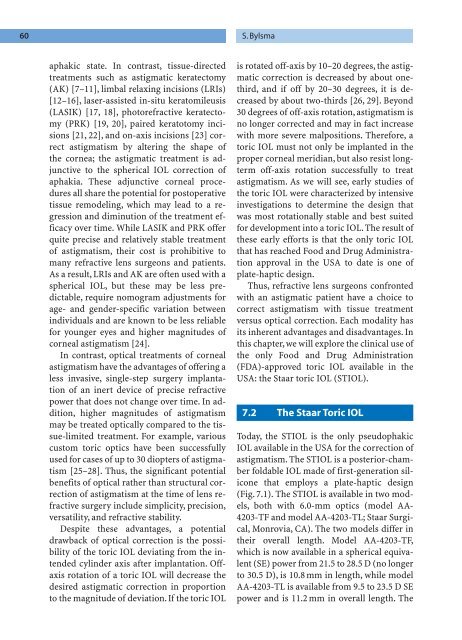Refractive Lens Surgery
Refractive Lens Surgery
Refractive Lens Surgery
Create successful ePaper yourself
Turn your PDF publications into a flip-book with our unique Google optimized e-Paper software.
60 S. Bylsma<br />
aphakic state. In contrast, tissue-directed<br />
treatments such as astigmatic keratectomy<br />
(AK) [7–11], limbal relaxing incisions (LRIs)<br />
[12–16], laser-assisted in-situ keratomileusis<br />
(LASIK) [17, 18], photorefractive keratectomy<br />
(PRK) [19, 20], paired keratotomy incisions<br />
[21, 22], and on-axis incisions [23] correct<br />
astigmatism by altering the shape of<br />
the cornea; the astigmatic treatment is adjunctive<br />
to the spherical IOL correction of<br />
aphakia. These adjunctive corneal procedures<br />
all share the potential for postoperative<br />
tissue remodeling, which may lead to a regression<br />
and diminution of the treatment efficacy<br />
over time. While LASIK and PRK offer<br />
quite precise and relatively stable treatment<br />
of astigmatism, their cost is prohibitive to<br />
many refractive lens surgeons and patients.<br />
As a result, LRIs and AK are often used with a<br />
spherical IOL, but these may be less predictable,<br />
require nomogram adjustments for<br />
age- and gender-specific variation between<br />
individuals and are known to be less reliable<br />
for younger eyes and higher magnitudes of<br />
corneal astigmatism [24].<br />
In contrast, optical treatments of corneal<br />
astigmatism have the advantages of offering a<br />
less invasive, single-step surgery implantation<br />
of an inert device of precise refractive<br />
power that does not change over time. In addition,<br />
higher magnitudes of astigmatism<br />
may be treated optically compared to the tissue-limited<br />
treatment. For example, various<br />
custom toric optics have been successfully<br />
used for cases of up to 30 diopters of astigmatism<br />
[25–28]. Thus, the significant potential<br />
benefits of optical rather than structural correction<br />
of astigmatism at the time of lens refractive<br />
surgery include simplicity, precision,<br />
versatility, and refractive stability.<br />
Despite these advantages, a potential<br />
drawback of optical correction is the possibility<br />
of the toric IOL deviating from the intended<br />
cylinder axis after implantation. Offaxis<br />
rotation of a toric IOL will decrease the<br />
desired astigmatic correction in proportion<br />
to the magnitude of deviation. If the toric IOL<br />
is rotated off-axis by 10–20 degrees, the astigmatic<br />
correction is decreased by about onethird,<br />
and if off by 20–30 degrees, it is decreased<br />
by about two-thirds [26, 29]. Beyond<br />
30 degrees of off-axis rotation, astigmatism is<br />
no longer corrected and may in fact increase<br />
with more severe malpositions. Therefore, a<br />
toric IOL must not only be implanted in the<br />
proper corneal meridian, but also resist longterm<br />
off-axis rotation successfully to treat<br />
astigmatism. As we will see, early studies of<br />
the toric IOL were characterized by intensive<br />
investigations to determine the design that<br />
was most rotationally stable and best suited<br />
for development into a toric IOL. The result of<br />
these early efforts is that the only toric IOL<br />
that has reached Food and Drug Administration<br />
approval in the USA to date is one of<br />
plate-haptic design.<br />
Thus, refractive lens surgeons confronted<br />
with an astigmatic patient have a choice to<br />
correct astigmatism with tissue treatment<br />
versus optical correction. Each modality has<br />
its inherent advantages and disadvantages. In<br />
this chapter, we will explore the clinical use of<br />
the only Food and Drug Administration<br />
(FDA)-approved toric IOL available in the<br />
USA: the Staar toric IOL (STIOL).<br />
7.2 The Staar Toric IOL<br />
Today, the STIOL is the only pseudophakic<br />
IOL available in the USA for the correction of<br />
astigmatism. The STIOL is a posterior-chamber<br />
foldable IOL made of first-generation silicone<br />
that employs a plate-haptic design<br />
(Fig. 7.1). The STIOL is available in two models,<br />
both with 6.0-mm optics (model AA-<br />
4203-TF and model AA-4203-TL; Staar Surgical,<br />
Monrovia, CA). The two models differ in<br />
their overall length. Model AA-4203-TF,<br />
which is now available in a spherical equivalent<br />
(SE) power from 21.5 to 28.5 D (no longer<br />
to 30.5 D), is 10.8 mm in length, while model<br />
AA-4203-TL is available from 9.5 to 23.5 D SE<br />
power and is 11.2 mm in overall length. The



